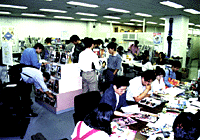
Imports by private individuals using mail-order catalogs have been stimulated by the rapid rise in the value of the yen since March 1995.
The word has gotten around that foreign goods can be imported inexpensively, and the Manufactured Imports Organization (MIPRO), an auxiliary organ of the Ministry of International Trade and Industry, estimates that the number of such imports will exceed 3 million cases this year.
MIPRO's individual import information center in Tokyo has over 1,500 foreign mail-order catalogs available for visitors' perusal. There is even a handbook for beginners.
Several hundred people visit each day to inquire about how to make individual imports and to look over the catalogs.
Individual importing boomed in the period between 1986 and 1989, when the value of the yen soared from 260 yen on the dollar to around the 160-yen level and then subsequently up to the 120-yen-per-dollar mark. The exchange rate later settled at around 150 yen on the dollar, but when it reached the 100-yen-per-dollar level in 1994, private imports surged again. They have increased especially rapidly since March this year, when the yen climbed to the 80-yen-per-dollar level, and a second boom is now under way.
Whereas men led the first boom, this time the leading shoppers have shifted to women, particularly young people. In 1987, 4.6 times as many men as women visited the information corner, but in 1994 their numbers were about equal. The ratio of young people under age 30 has also risen from 34% to 45%. Moreover, whereas imports made during the first boom centered on luxury brands, which gave the purchaser the feeling that the import was a bargain, this time imports made by both men and women center on apparel, with no particular preference for name brands. Other popular items among men are equipment for outdoor sports and haberdashery, and among women, items for children and the home.
In November and December 1994, when the exchange rate was running at 90 yen on the dollar, MIPRO took a questionnaire survey of 1,100 visitors to the information center who said they had made individual imports in the past. The responses indicated that there had been 895 incidents of imports of adult clothing, followed by 177 purchases of children's clothing, 143 of haberdashery and accessories, and 113 of outdoor sporting goods. Some people had even made purchases worth several million yen, including automobiles and log houses. The price range for single items fell between 10,000 and 20,000 yen in 29.3% of cases, followed by 20,000 to 30,000 yen in 28.7%.
A majority (52.5%) of those who had made individual imports had experienced dissatisfaction or trouble of some sort. Their main complaints were that tariffs and shipping costs had been higher than expected, that importing took too much time, that sizes or specifications did not meet their needs, or that the wrong item had been sent. Despite this, however, fewer than 10% of the respondents said they had had enough of individual importing, and over 90% said that they wanted to continue making their own imports.
One Tokyo department store has tied up with a German mail-order firm to handle individual imports. The German company's 900-page catalog, which lists about 55,000 items, can be bought or viewed at the department store, where orders are placed. The ordered item is delivered to the customer's home by air parcel in about a month. No agent's fee is charged; the customer pays the price of the item, shipping costs, taxes, a customs fee, and a flat fee of 500 yen to cover the cost of transferring the remittance. Although the value of the mark does not shift relative to the yen as sweepingly as the U.S. dollar, the exchange rate varies from day to day, so many customers aim to reap the benefits of instantaneous rises in the yen. Women account for 90% of those taking advantage of this system, and recently more young people are also utilizing it.
Most observers in the mail-order industry feel that the yen will be high for some time to come, and a succession of major mail-order houses have begun acting as agents for individual imports. Partly because of this, knowledge of individual importing is spreading rapidly, and in the future more people will probably start taking advantage of this system.
(The above article, edited by Japan Echo Inc., is based on domestic Japanese news sources. It is offered for reference purposes and does not necessarily represent the policy or views of the Japanese Government.)